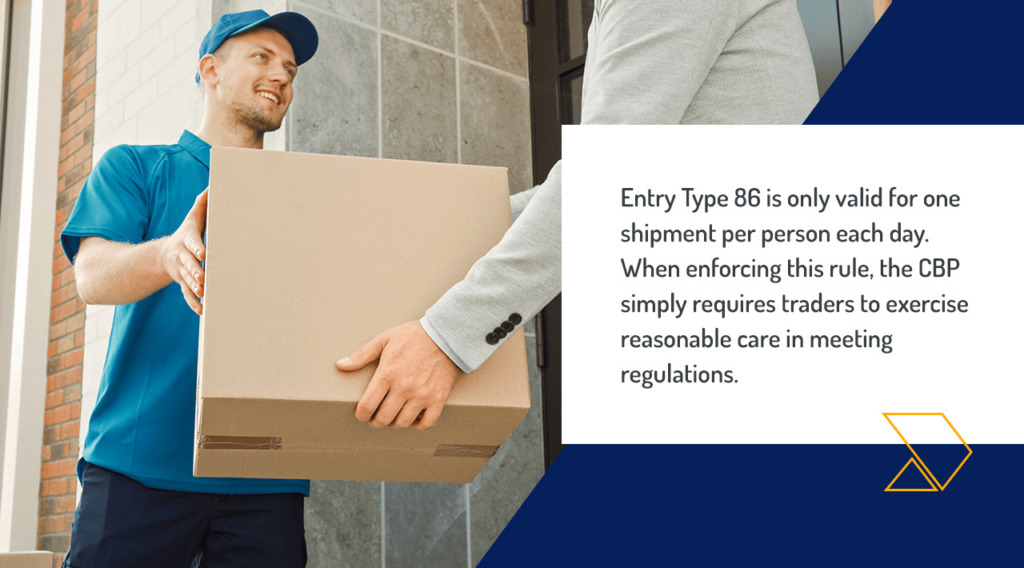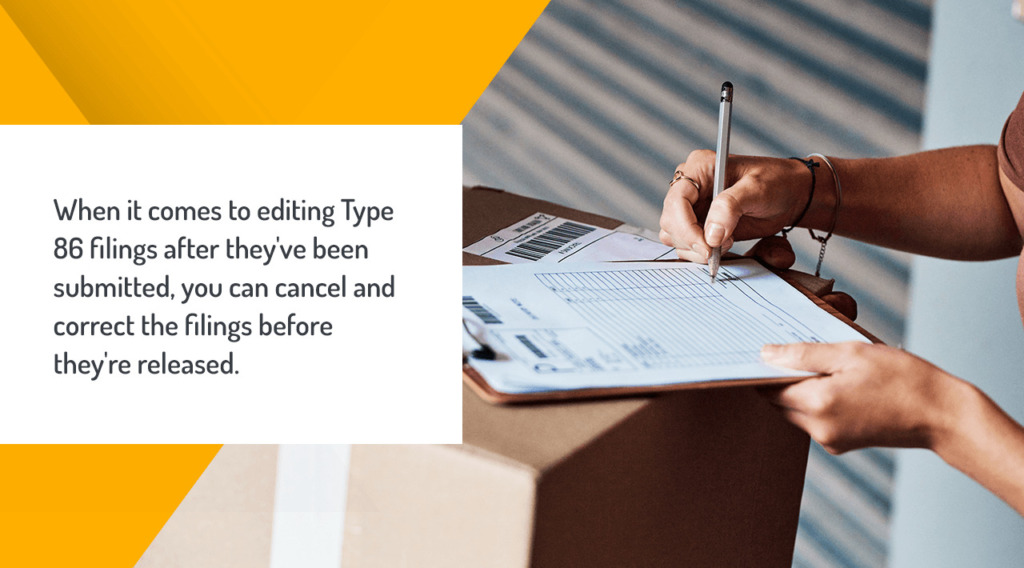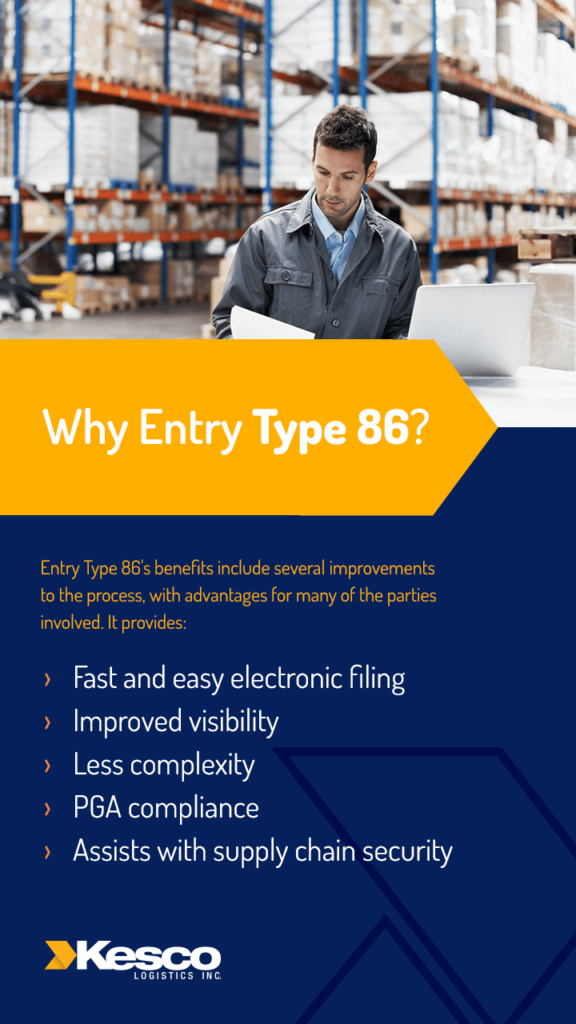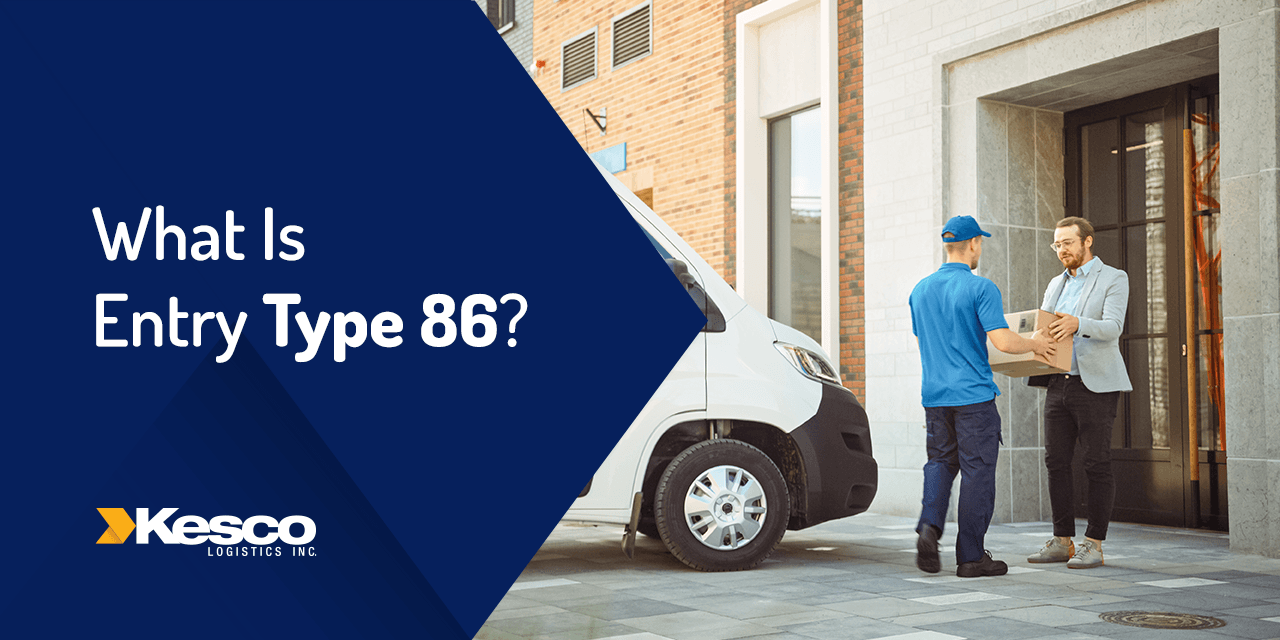About Entry Type 86 | What’s Covered Under Type 86? | What Kind of Information Do I Need for Type 86 Forms? | Modifications and Cancellations | Type 86 vs. Other De Minimis and Section 321 Shipments | Why Entry Type 86? | Type 86 for E-Commerce Providers | Working With a Broker
With today’s ever-evolving global market, more businesses want ways to ship their goods with as much speed and as little cost as possible. Entry Type 86 is an excellent method to get there, offering an expedited, electronically filed option for the import of low-value goods overseen by United States Customs and Border Protection (CBP). These items would otherwise require more complex Section 321 filings. Both small and large businesses can take advantage of Entry Type 86 to save costs and provide fast shipping times for qualifying items.
Entry Type 86 can be a significant benefit to e-commerce businesses that send low-value products across the U.S. border. It eliminates the taxes, duties and fees associated with other filing types and accelerates the process, improving profits, efficiency and shipping speeds. Entry Type 86 offers a variety of benefits for your fulfillment operations. Let’s take a closer look at this useful clearance type and Entry Type 86 FAQs.

About Entry Type 86
Entry Type 86 is part of Section 321 of the Tariff Act of 1930, and it builds off of parts of the North American Free Trade Agreement (NAFTA). Section 321 refers to de minimis shipments, where the retail value of de minimis items is under $800 in the country of shipment. These items are considered informal entries, which do not require a bond and can be used for commercial or personal use.
Section 321, Entry Type 86 expands upon the items that are considered informal-entry products, eliminating duties and taxes for those items, allowing for faster electronic filing and improving visibility for regulatory agencies. Items that are not considered informal are charged duties and use a more time-consuming process called release from manifest. This process is not applicable to items that are regulated by Partner Government Agencies (PGAs).
The process for Entry Type 86 requires the owner, purchaser or designated customs broker to complete a CBP form in the Automated Commercial Environment (ACE), an electronic portal. They must submit this information either before arrival or within 15 days of the cargo reaching the port of arrival. Brokers must have power of attorney and become the Importer of Record (IOR), providing the IOR number required for approval. They must also be compliant with any applicable requirements and have access to the Automated Broker Interface (ABI) with the CBP.
Entry Type 86 is only valid for one shipment per person each day. When enforcing this rule, the CBP simply requires traders to exercise reasonable care in meeting regulations. Note that the CBP does not allow separating shipments into multiple parts with lower values to take advantage of entry Type 86. In addition, importers cannot consolidate multiple shipments into one Entry Type 86 shipment — Type 86 uses one master or house bill.
What’s Covered Under Type 86?
While Entry Type 86 goods include many different shipments that are less than $800, one notable inclusion is goods that typically fall under formal entry due to regulation by PGAs. PGAs play a role in the acceptance of items. Some examples of PGAs include the Food and Drug Administration (FDA), the Food Safety Inspection Service (FSIS) and the Fish and Wildlife Service (FWS).
Most items being imported will fall under the jurisdiction of some type of PGA. For instance, in addition to food and drugs, the FDA also covers items like toothbrushes, makeup and medical devices. The FSIS, on the other hand, covers items like meat, poultry and eggs, ensuring they meet the same level of quality as domestically produced products.
Type 86 applies to these items and allows for cost-effective imports on items valued at less than $800 in their country of origin. One exception is if there is a fee imposed by the PGA on the item, which would disqualify it from Type 86. In this case, the shipment would be cleared under a Type 01 formal entry or a Type 11 informal entry, depending on the item’s value.
Another benefit to Type 86 is that it covers items that come from any mode of transport. With a Section 321 import, traders must complete a release from manifest, but the electronic filing program only allows this for truck and air shipments. Type 86, on the other hand, is appropriate whether the shipment comes by air, land or sea.
So, what is not covered by Type 86? These items include:
- Goods subject to antidumping and countervailing duties (AD/CVDs)
- Certain agriculture, tobacco and alcohol products
- Goods subject to quota
- Goods taxed under the Internal Revenue Code
AD/CVDs can vary by country and include a range of products — you can look up specifics on the U.S. Department of Commerce’s website. These duties are imposed to prevent the sale of items within the U.S. at prices below fair market value. As for quotas, they can include absolute, tariff-rate and tariff preference level quotas, all of which restrict the number of goods allowed into the U.S. within a certain time period.
What Kind of Information Do I Need for Type 86 Forms?
When filing Entry Type 86, an importer or broker will submit the following information:
- Air waybill number or bill of lading
- 10-digit Harmonized Tariff Schedule (HTS) number
- Entry number
- Fair retail value of goods in the country of shipment
- Planned port of entry
- Quantity of items
- Consignee’s name and address
- Shipper’s name, country and address
- Country of origin
- IOR number of the broker, owner or purchaser if designated by the consignee — required by traders if shipments meet reporting requirements from PGAs
The HTS number, also called an HS code, is part of a large worldwide system that makes merchandise identification easier as it crosses international borders. These numbers, collected by the CBP, identify the type of cargo entering the U.S. and allow them to keep tabs on what’s being sent through the border.
There are tons of different HTS numbers for subtly different products, and they’re usually not required for low-value items, but they are needed for Type 86 products. Because Type 86 uses an HTS number, it is considered a customs business filing.
This usage is one significant difference between Type 86 and other clearance types. For many traders, an HTS number is a small price to pay for the fast processing and cost-free import of their low-value items. The same can’t be said for some other shipping methods, like express consignment carrier facilities and container freight stations. These options can also be limited to a few carriers that are licensed to use them.

Modifications and Cancellations
When it comes to editing Type 86 filings after they’ve been submitted, you can cancel and correct the filings before they’re released. Post Summary Corrections (PSCs), however, cannot be filed.
Type 86 vs. Other De Minimis and Section 321 Shipments
Type 86 is a subset of Section 321, but you may be wondering how the two differ. Here are a few ways:
- HTS requirements: The HTS number is an important part of Type 86 entries and is not often required for other types of shipments.
- Brokers: Type 86 requires a customs broker that operates as the Importer of Record, whereas Section 321 allows forms to be submitted by the carrier, purchaser, shipment owner, consignee or broker.
- PGA regulations: Regular Section 321 shipments use the release from manifest process, but items regulated by PGAs cannot use this method and must be filed in another way. Type 86 allows for these PGA-regulated items to be treated as de minimis shipments without the associated duties and fees.
- Shipment types: While Section 321 can only process shipments by air or truck, Entry Type 86 processes shipments from all modes of transportation.
- Remote filing: Not all Section 321 shipments can be filed remotely, but Type 86 can, contributing to its efficiency and processing speed.
Types of Shipments That Can Be Filed as Entry Type 86
While there are some differences between Type 86 and other clearance methods, there are also several entry types that can be filed as Type 86 if the products fit the requirements.
Chapter 98, for instance, refers to returned items that come back to the U.S. in equal or worse condition than they were in when they originally left the country. If you have an item that would fall under Chapter 98, it can be imported via Entry Type 86.
Similarly, Chapter 99 commodities can be filed under Type 86 if the appropriate HTS number under Chapters 1-97 is used. Entries subject to requirements from Sections 301, 201 and 232 can also be applicable for Entry Type 86.
In these instances, the same Entry Type 86 restrictions would apply, preventing PGA-regulated items, AD/CVD items and others that would disqualify a shipment from Entry Type 86.

Why Entry Type 86?
Entry Type 86’s benefits include several improvements to the process, with advantages for many of the parties involved. It provides:
- Fast and easy electronic filing: Electronic filing through the broker interface is much faster and easier, delivering expedited and remote entry for these low-value shipments that can save a company and its customers time and get products into consumers’ hands much faster. It’s an efficiency-boosting tool for just about everyone involved and can help you improve your customers’ experiences.
- Improved visibility: Through the expanded visibility into the products crossing the border, CBP is able to ensure greater security and safety for these items with more comprehensive data collection. Anyone who needs access to ACE can get to these reports for easy regulatory compliance and assurance, supporting legitimate trade. The CBP can quickly track and target risky shipments coming through and investigate appropriately without slowing down legitimate shipments.
- Less complexity: Type 86 is a simpler approach to low-value items that’s a bit easier to work through, reducing frustration and processing time.
- PGA compliance: Within ACE, brokers and importers can file the information that PGAs require in one place. The informal entry status also helps PGAs identify product compliance and makes it easier for them to conduct reviews and enforcement.
- Assists with supply chain security: Knowing that your products will get through customs quickly is an important part of keeping businesses moving. Through Type 86, filing happens faster and can be ready to go before the items even arrive in port.
Regardless of business size, entry Type 86 can be a significant benefit to businesses importing low-cost goods, from clothing and painkillers to microwaves and beef.
Type 86 for E-Commerce Providers
For e-commerce providers, Type 86 can be a particularly big help in two different areas. First, it offers e-commerce businesses the ability to ship to the consumer directly from the country of origin without any handling or warehousing within the United States. The other big advantage of Type 86 is that it completely eliminates duty costs, saving money in the delivery process.
Other benefits include:
- Customer satisfaction: Faster clearance means faster shipments, which create happier customers. The speed of the Entry Type 86 process can get items across the border much quicker and help you gain and retain your loyal customers through speedy service.
- The bottom line: Shipping costs are often passed onto the customer through explicit charges or higher product prices, or the costs can simply be eaten up by company profits. If you’re not paying extra fees for every shipment, you’re saving costs, however they appear for your organization or customers. Plus, you’re not paying for the effects of processing delays or expensive shipping methods.
- Efficiency: With the help of a simple customs process, e-commerce shipments can save time and money by requiring less labor to file shipments. Working with a broker also allows your team to focus on their work.
Whatever it is you’re selling, the right approach to customs can be an important component of attracting and keeping customers and improving the profitability of your business.
Working With a Broker
Entry Type 86 filings can be performed by a licensed customs broker with access to the electronic filing programs connected to the CBP. But not all brokers can offer the same level of service. At Kesco Logistics, we provide a comprehensive range of services, including Entry Type 86 filing for e-commerce customers. And all of our services, like freight tracking and foreign fulfillment, come with an exceptional level of care and attention to detail.
We do more than just implement Entry Type 86 practices — we also help you maximize their effects for wide-reaching benefits across your organization. We do this through:
- Customs brokerage services: Our licensed customs brokers can keep things moving. Get peace of mind knowing your shipments get to their destination quickly and without extra costs.
- Foreign 3PL fulfillment: With our large network of fulfillment centers throughout Asia, Kesco can take care of handling requirements in the origin country for maximum savings and optimization for the delivery process.
- Logistics services: Whether by air or by sea, Kesco professionals find the best prices for freight forwarding at the level of service your organization needs.
If you want to improve the customs process and find savings for your e-commerce organization, Kesco Logistics can help. To learn more, check out our services page on Entry Type 86, and reach out to us to talk to an expert.



